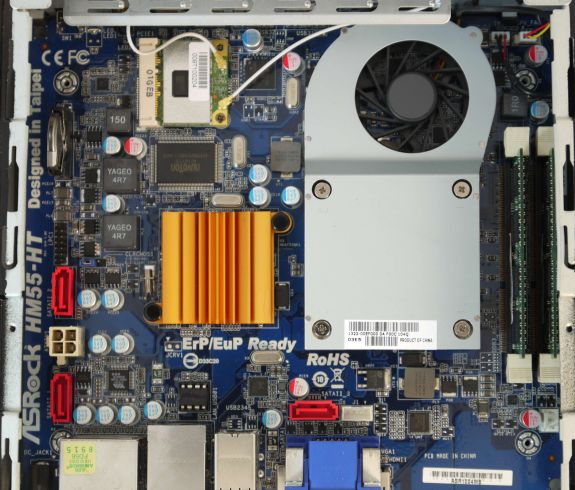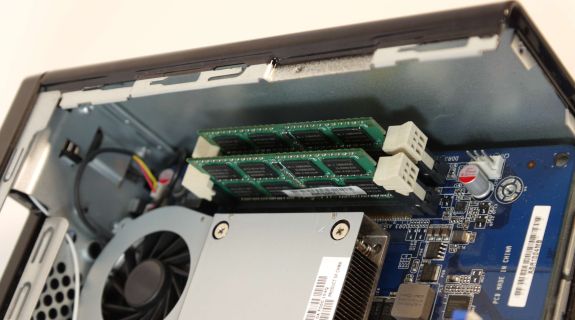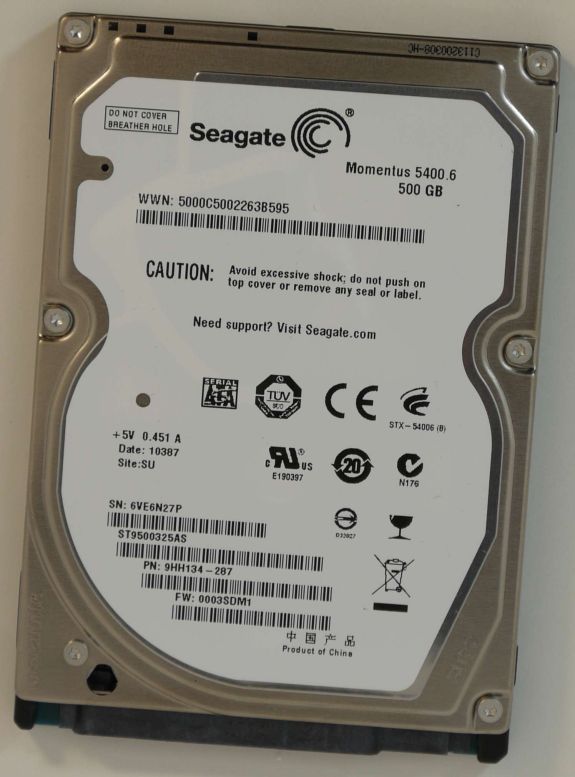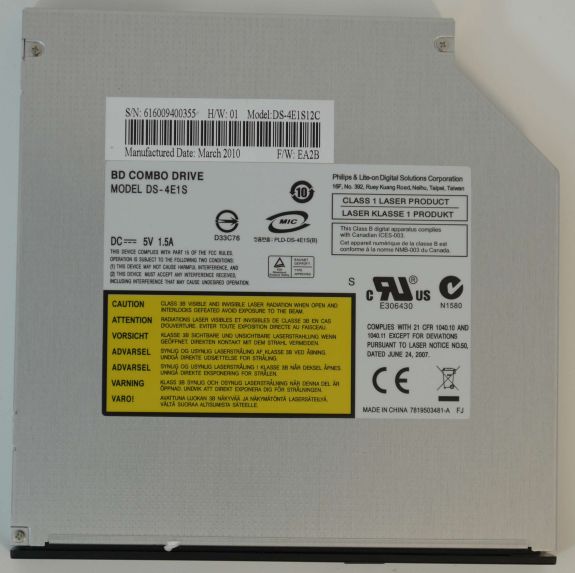ASRock Core 100HT-BD : Bringing HTPCs to the Mainstream Market [UPDATED : Noise Issue]
by Ganesh T S on July 19, 2010 9:34 PM EST- Posted in
- Home Theater
- Arrandale
- ASRock
- Media Streamer
- Core i3
- HTPC
Analyzing the system specifications reveals one clear advantage for ASRock. It is not going to be possible for the average HTPC enthusiast to build a similar system himself with off-the-shelf components. The reason lies in the fact that the Arrandale processor used in the system is currently available for OEM purchase only. All the processors available for general purpose (the Clarkdales) do not fit in the same power envelop as the Arrandales. We covered the Arrandale platform in detail earlier, and concluded that it had a very good power consumption / performance balance. In this section, we will analyze each of the system components in detail.
Motherboard & Chipset: mini-ITX Mobile Intel H55 Express
Over the last 6 months, we have seen many motherboards featuring the H55 chipset. In the mini-ITX form factor, we have covered Zotac's offering as well as Gigabyte's. However, both of them are meant for the desktop Clarkdale processors. What we see in the Core 100 HT-BD is more similar to the motherboards one sees in notebooks. Feature wise, the ASRock motherboard can be compared with the Gigabyte version, since both have support for USB 3.0 ports. However, being a mobile platform, there are some important differences. Tagging on USB 3.0 ports to the HM55 chipset is fraught with issues (more on this in the Performance section). Also, there is no PCI-E x16 slot in the motherboard because the chipset doesn't support it. DVI and PS2 ports are also absent. However, compared to the Gigabyte board, we have two extra USB 2.0 ports. The odd thing to observe here is that ASRock has decided to go with a VGA port instead of DVI, and providing us with a HDMI to DVI adapter, instead of providing a DVI port with a DVI to VGA adapter for folks with older equipment.
Rounding up the other components of the motherboard, we have the Realtek RTL8111E for GbE, and the VIA VT2020 for audio. The mini PCI-E expansion slot is occupied by the Atheros AR9287 module capable of 300 Mbps. As can be seen from the photograph, we have wires connected to the side panels, which act as antennae for the wireless signals. Like many other offerings in the market, ASRock also uses NEC's USB3 controller, giving the system two USB 3.0 ports. Another interesting chip on the board is the Nuvoton NCT6775F. It handles all the sensors (fan speed, temperature etc.) and also the IR support for the MCE remote.
The H55M chipset supports upto 4 SATA ports. In the Core 100 HT-BD, two of them are used by the Blu Ray drive and the hard disk. One of them is free for use by an optional 2nd hard drive (or SSD). The last one is made available as an eSATA port on the back panel. The mini-PCIE slot, as already mentioned, is taken up by the wireless module. In essence, the Core 100-HT BD's motherboard is a notebook motherboard in the mini-ITX form factor.
The Gigabyte mini-ITX (based on the H55) with the USB 3.0 ports can be purchased from Newegg currently for around $100. Since ASRock's version is based on the mobile version of the chipset, and also has a THX certified audio codec chip, the cost is bound to be slightly higher. One must also take into consideration the cost of the Atheros AR9287, which can be bought for around US $15 online. For the purpose of cost analysis, let us assume that one may theoretically be able to purchase a similar motherboard for US $140.
CPU & GPU: Intel Core i3-330M @ 2.13 GHz, iGPU @ 667 MHz
For the form factor and thermal design of the Core 100 HT-BD, only processors with a maximum TDP of 35W are supported. Also, most HTPCs do not require features like Turbo Boost, particularly when their performance exceeds what people have come to expect out of a particular form factor (talking about the Atom nettops) by a magnitude. Keeping in mind the cost of the processors and the nett cost of the system, ASRock has decided to go with the lowest end of the Arrandale spectrum, namely, the Core i3-330M. We feel that this is a very good choice, as the processor is powerful enought for most of today's demanding tasks, particularly from a HTPC perspective.
The integrated GPU is clocked at 600 MHz by default in the system, but it can be easily overclocked to 900 MHz without much effect on fan noise or any concerns about the system heating up. Most HTPC users are more interested in turning down the heat and power consumption. Towards this, attempts are made to undervolt or underclock the CPU. In our opinion, for the Core 100 HT-BD, the savings obtained through these methods are not worth the trouble. Intel's SpeedStep technology is enabled on this system, and we observed that the cores would clock around 940 MHz when doing light browsing tasks, and kick upto 2.14 GHz under heavy load. It is easy to overclock the system too (from within Windows, as well as the BIOS), but the need would probably be never felt in a HTPC usage scenario.
The pricing of the Core i3-330M is available only to OEMs. Our sources, however, informed us that it costs around US $135 in high volume.
DRAM: Elixir Memory's 2 x 2GB Nanya DDR3 @ 1066 MHz
The Core 100 HT-BD has two DDR3 slots, both of which are occupied by the 2 GB Nanya DIMMs. One can potentially use 4 GB DIMMs to get 8GB of system memory, but that would be an overkill from the HTPC perspective. ASRock's choice of 4GB is more than enough for the HTPC.
The 2 DIMMs can be bought currently for around $100 in total from resellers in the US.
Hard Disk: Seagate Momentus 2.5" 5400 rpm 500 GB
Since the form factor of the build indicates that the system is more of a notebook, the hard drive inside is a 2.5" model. ASRock has gone in with the Seagate Momentus 5400 rpm drive. While one might prefer a faster drive for installing the OS, there is no doubt that the lower power consumption of this unit makes it an ideal choice for the HTPC. There is enough space inside the system for an additional 2.5" drive, and filling that up with a SSD would be a great choice for the boot drive. The shipped Seagate drive is ideal and capacious enough for HTPC duties.
The hard drive can be currently had from Newegg for US $65.
Optical Disk Drive: Philips / Lite-On Blu-Ray / DVD RW
The Core 100 HT-BD model ships with the Lite-On DS-4E1S Blu-Ray / DVD RW drive. Again, this is a model meant for notebooks, with the tray not coming out fully when ejected. It can be found online for around $90 without shipping charges taken into consideration.
Miscellaneous Components
The chassis is obviously custom made for this motherboard. ASRock also throws in the SATA, power cables and screws for the optional 2nd hard drive. Mini-ITX cases with PSUs of much higher rating (the unit comes with an external 90W adapter) can be had for around US $50. So, we estimate the cost of the chassis, power adapter and other similar accessories to be around the same. Note that the unit also ships with an IR based MCE remote. Though the build quality of the remote is not high end in nature, we estimate that it adds around $30 to the cost.
Cost Analysis
| ASRock Core 100HT-BD Pricing Analysis | ||||
| Component | Average Price Online | |||
| Motherboard (with mini-PCIe wireless) | $140 | |||
| CPU | $135 | |||
| DRAM | $100 | |||
| HDD | $65 | |||
| Optical Drive | $90 | |||
| MCE Remote & IR Receiver | $30 | |||
| Misc Components (Chassis, Power Adapter, Cables, etc...) | $50 | |||
| Total Cost to Build | $610 | |||
| ASRock Core 100HT-BD Estimated Cost | $700 | |||
Newegg is supposed to have this HTPC for sale soon around the $700 price point. (The model with the DVD drive instead of the Blu-Ray is already on sale for $650.) With only a $90 premium over a home built HTPC, this is not a bad investment from the value viewpoint. Do note that the cost of the OS and keyboard / mouse have to be added on to this to get a sense of the true cost of the system. Also, we still have to take a look at the unit from various other perspectives. Read on to find out more.














107 Comments
View All Comments
ganeshts - Tuesday, July 20, 2010 - link
Shadowmaster625,This unit is slightly on the leading edge (The Arrandales were introduced around 6 months back).
With $100, it is difficult to get a notebook with HD audio bitstreaming and Blu-Ray drive, even second hand.
For the set of features it offers, we think it is a decent value for money. As for this being mainstream, I am sure there are many who spend $700 or so on a PC once every 4 - 5 years, and this is a perfect system for such people.
tmservo - Tuesday, July 20, 2010 - link
Pray tell.. if you've got a way to get a case/motherboard/ram/hdd/bluray drive and get 1080P for under $100, I'm interested. Somehow, I don't see that as at all feasible. Hell, even the cheapest AMD CPU + board and a cheap case alone is $100. So, however you shoe horn in all those other components, or then get the software to run them (supplied here) ..But, if you'd like.. give me a part list of what you can get that anyone could go buy, NEW, for $100.
Or, find me a used laptop on Ebay with HDMI output that does 1080P and has a bluray drive for $100. Even if it has no screen. Needs to have a HDD, Memory, BD drive though.. and function.
cjs150 - Tuesday, July 20, 2010 - link
53 db!! That is just plain daft.I suspect the design of the case does not help.
I have just built a mini-server using a Atom 510 and I am sure the M/B was ASrock, mini-itx format and a PCI-E slot. Easiest build I have done even though the case was not perfect. As a server it is effectively silent
I do not want an HTPC that creates any more noise other than maybe a slow running 140mm+ fan
ganeshts - Tuesday, July 20, 2010 - link
cjs150,Note that the 53dB is under full load, when all threads are pegged at 100%, and it is just inches away from the unit. The farther you are, the lesser it is, and at 8ft, it was barely discernible.
Under idle, the unit is advertised as having 25dB noise, measured in an anechoic chamber (Refer YouTube video from their marketing department).
I would say, for HTPC purposes, the noise from the unit is definitely within limits.
tech6 - Tuesday, July 20, 2010 - link
Nice work Ganesh - I look forward to further HTPC reviews to see how the AMD platforms compete.shamans33 - Tuesday, July 20, 2010 - link
Ganesh,I'm curious as to how the IR receiver is connected to the motherboard...USB and/or motherboard headers? Is it possible to do a force power off (if let's say the system is frozen) or to do a cold boot up?
Thanks for reviewing more SFF items.
ganeshts - Tuesday, July 20, 2010 - link
shamans33,I believe the IR receiver is connected to a dedicated NuvoTon chip on the motherboard.
The power off button on the remote puts the system in sleep mode when the unit is in operation. In my usage scenario, I had the AC adapter connected to the back of the unit, and the system was completely shutdown. The Power button on the remote was able to boot up the unit without issues (even with Instant Boot disabled).
johnspierce - Tuesday, July 20, 2010 - link
Hi Ganesh,Very nice review, extremely thorough, thank you!
I have a question about how the HDMI handshaking works with the ASRock.
I have built several HTPC's with both NVidia and ATI HDMI-out video cards and it seems they all have a problem when I have it plugged into my HDMI-switching Onkyo receiver.
When I switch from HTPC to DVR and don't change back for awhile, it always has a problem with the display coming "alive" on the switch back. Turning the monitor off and on re-establishes the handshake, but this is an annoying trait of the current crop of video cards. Does the ASRock have this problem?
Also, I wanted to "weigh in" on the lack of a TV tuner -- I really think this is quickly becoming a non-issue since I now use an OTA receiver for local HD and everything else gets streamed. TV Tuners will soon be an anachronism in my opinion.
Thanks,
John
ganeshts - Tuesday, July 20, 2010 - link
johnspierce,I have the same handshaking issue with my ATI based HTPC.
As far as I could see, I didn't have the handshaking issue with the ASRock setup, but the whole testing was done with 2 displays connected to it. I will do a 'standalone' test and get back to you on this.
Aikouka - Tuesday, July 20, 2010 - link
A very interesting product indeed, but I've got my own three cents to provide!1) The price. Ouch... when I first opened this review, I checked the Egg to see if they had them in. Of course as the review mentions, I ended up finding the DVD-equipped model for $650. Tack on another $130 for Windows 7 Professional (note, I use Pro since it enables remoting in, which I find indispensible for a HTPC) and you've got nearly $800. If the Blu-Ray-equipped model retails for $700, you get $830 with the OS and then you have to consider that the blu-ray playback software will set you back another $100 (unless you can find them on sale... TMT3 has been on sale for $75 before).
I've spec'd out a few HTPCs in my quest to find the Holy Grail of HTPC devices, and if price were my main concern, I'd still probably go with my own build. I never put my HTPCs to sleep, so I'm honestly not even worried about that aspect and I don't mind a slightly higher power consumption.
2) The VIA VT2020. Have you noticed a strange amount of memory use from having this? I have an ASUS P7P55D-E Premium motherboard, which also features the same VIA audio chip, and I have god awful levels of memory use from audiodg.exe (Window 7's audio "controller"). At one point before upgrading my BIOS, I would literally see 800MB of memory being used by it. Last night I checked and I had 130MB of memory being used and I only had a single mp3 open. The worst part is that the last time I checked, VIA does not provide audio drivers for that chip. On their website they said that it was manufactured specifically for ASUS and to check their website for drivers.
But who knows... the strange things I see are possibly just issues with the P7P55D-E Premium... it's a god awful motherboard that was released with buggy BIOS revisions and it's no wonder you can't even buy it from NewEgg anymore.
3) The Front. Why do people want to see things like USB ports, bright blue LEDs and 3.5mm ports on the front of entertainment center components? The worst offender of the "sleak front" has to be that ghastly Intel i3 Inside sticker. I'd rather the connections be hidden under some sort of flap or door if they absolutely have to be on the front.
4) The remote. As something to mention, when I was discussing HTPC stuff on the Anandtech forums, a user clued me in on a nice Gyration MPC-capable remote that you could buy off eBay (from Lenovo it looks like) for only $50 that provided some mouse support if you ever needed it. I have to say that I quite like it so far and it might be something to look into if you don't like IR remotes. The only negative aspect is the ugly and obtuse dongle.
5) The comparison. It'd be nice to see how this item really compares to it's cousin, the ATOM-based version. Given the blu-ray version is available for $500 on NewEgg, does it handle all the necessary playback? A $200 savings for slightly longer application loads might be somewhat advantageous. Right now, I literally just leave my HTPC turned on 24/7 with WMC loaded up, so other than any necessary start-ups/shut-downs, I may see very little difference with the ATOM version.